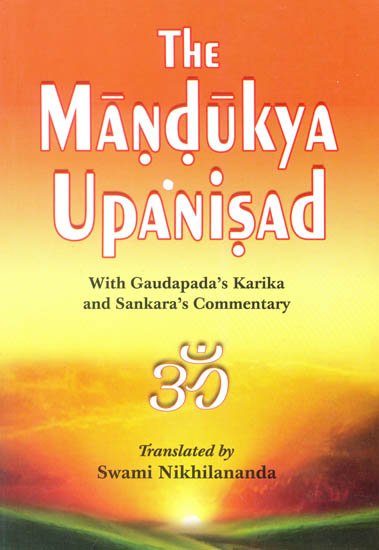Mandukya Upanishad (Gaudapa Karika and Shankara Bhashya)
by Swami Nikhilananda | 1949 | 115,575 words | ISBN-13: 9788175050228
This is verse 4.22 of the Mandukya Karika English translation, including commentaries by Gaudapada (Karika), Shankara (Bhashya) and a glossary by Anandagiri (Tika). Alternate transliteration: Māṇḍūkya-upaniṣad 4.22, Gauḍapāda Kārikā, Śaṅkara Bhāṣya, Ānandagiri Ṭīkā.
Mandukya Karika, verse 4.22
Sanskrit text, IAST transliteration and English translation
स्वतो वा परतो वाऽपि न किंचिद्वस्तु जायते ।
सदसत्सदसद्वाऽपि न किंचिद्वस्तु जायते ॥ २२ ॥svato vā parato vā'pi na kiṃcidvastu jāyate |
sadasatsadasadvā'pi na kiṃcidvastu jāyate || 22 ||22. Nothing, whatsoever, is born either of itself or of another. Nothing is ever produced whether it be being or non-being or both being and non-being.
Shankara Bhashya (commentary)
For this reason, also, nothing whatsoever is born. That1 which is (supposed to be) born cannot be born of itself, of another or of both. Nothing,2 whether it be existing or non-existing, or both, is ever born. Of such an entity, birth is not possible in any manner whatsoever. Nothing3 is born out of itself, i.e., from its own form which in itself has not yet come into existence. A jar cannot be produced from the self-same jar. A thing cannot be born from another thing, which is other than itself, as a jar cannot be produced from another jar, or a piece of cloth from another piece of cloth. Similarly, a thing cannot be born both out of itself and another, as that involves a contradiction.4 A5 jar or a piece of cloth cannot be produced by both a jar and a piece of cloth.
(Objection)—A jar is produced1 from day, and s son is born of a father.
(Reply)—Yes, the deluded use a word like “birth” and have a notion corresponding to the word. Both the word and the notion are examined by men of discrimination who wish to ascertain whether these are true or not. After examination they come to the conclusion that things, such as a jar or a son, etc., denoted by the words and signified by the notions, or mere verbal6, expressions. The Scripture also corroborates it, saying, “All effects are mere names and figures of speech.” If the thing is ever-existent, then it cannot be born again. The very7 existence is the reason for non-evolution. A father8 of clay is the illustration to support the contention. If these objects, on the other hand, be non-existent, even then they cannot be said to be produced. The very-non-existence is the reason. The horns9 of a hare are an illustration. If things be both existent and non-existent, then also, it cannot be born. For, such contradictory ideas cannot be associated with a thing. Therefore it is established that nothing whatsoever is born. Those10 who, again, assert that the very fact of birth is born again, that the cause, the effect and the act of birth form one-unity, and also that all objects have only momentary existence, maintain a view which is very far from reason. For a thing immediately after being pointed out as “It is this,” ceases to exist and consequently no memory of the thing is possible in the absence of such cognition.
Anandagiri Tika (glossary)
There are six possible alternatives in the case of the birth of a thing. It is either born of itself, or of another, or of both. That, which is born is either existing or non-existing or both. This Kārikā shows the absurdity of all these positions and conclusively establishes the theory of absolute non-evolution.
1 That, etc.—That is to say, the three alternatives are denied regarding the cause.
2 Nothing, etc.—In other words the three alternatives are denied regarding the effect.
3 Nothing, etc.—Both always means change. If a thing produces another thing, it cannot do so without a change in itself. If it undergoes a change, it ceases to be the thing itself. Therefore a thing cannot be the cause of the same thing. A jar cannot be the cause of the very same jar.
4 Contradiction—For, a cause cannot, at the same time, combine within it two contradictory aspects.
5 A jar, etc.—Therefore an object which is supposed to be born cannot be born from a cause which is both existing arid non-existing.
6 Verbal, etc.—It is because the birth of a son or the production of a jar cannot be proved,
7 The very, etc.—Birth signifying a change would indicate that the thing, before it was born, had been non-existent. This previous non-existence cannot be reconciled with the idea of its being ever-existent.
8 Father, etc.—If the son or the jar be ever-existent, then they cannot be born from a father or clay.
9 Horns, etc.—Horns of a hare are ever non-existent. Hence no birth can be predicated of them.
10 Those, etc.—This is the view of the Buddhist idealists. According to them, no external objects, corresponding to our idea of them, exist. Idea alone is real. One idea gives birth to another idea. These ideas are momentary. The moment an idea is cognised as such, it vanishes giving birth to another idea. All our notions regarding the cause, the effect and the act of birth form only one unit idea. But this position is absolutely untenable. If one idea be immediately succeeded by another idea, then the antecedent idea is no longer cognised by us. In the absence of such cognition, no memory is possible. If an idea has only a momentary existence, then our very possibility of experience becomes an absurdity. If there cannot be any memory of the antecedent idea, then it is not possible to establish a causal relation between the antecedent and the subsequent ideas.
